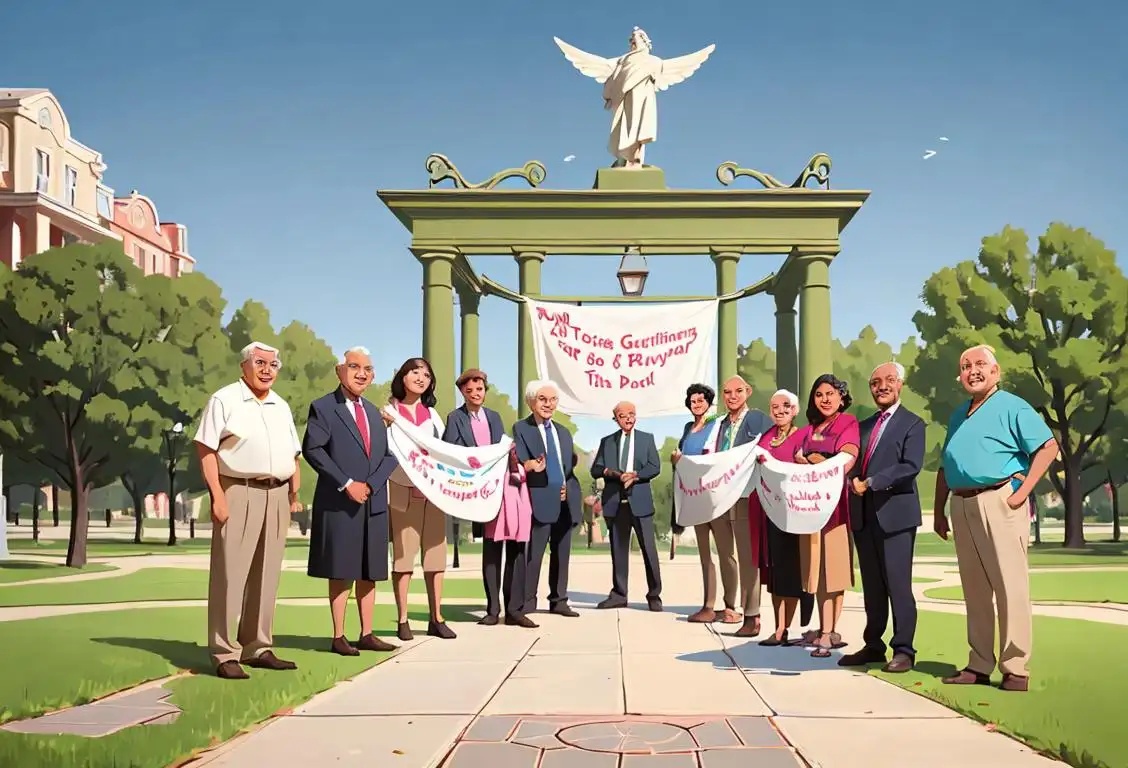National Boy Scouts Day

Ah, National Boy Scouts Day! A day dedicated to celebrating the young adventurers who embrace the great outdoors, learn invaluable life skills, and practice the art of tying knots and building fires. It's a day to honor the Boy Scouts of America and all they stand for. So, grab your compass and scout uniform, because we're about to embark on a wild journey through the internet history of this special day!
When is Boy Scouts Day?
It's national boy scouts day on the 8th February.
The Internet History of National Boy Scouts Day
On this marvelous day, the internet brims with excitement as people from all corners of the digital world unite to pay tribute to the Boy Scouts. The origins of National Boy Scouts Day date back to February 8, 1910, when the Boy Scouts of America were officially established, forever changing the lives of young boys across the nation. It was a momentous occasion that gave birth to an organization dedicated to molding future leaders, fostering character development, and embracing the wonders of outdoor adventures.
Ever since that fateful day in 1910, the Boy Scouts of America have grown in both size and influence. They have helped countless kids discover the joy of camping, develop essential survival skills, and earn countless merit badges to showcase their achievements. From first aid to wilderness survival, from leadership to citizenship, the Boy Scouts offer a smorgasbord of knowledge for those brave enough to embark on this incredible journey.
But what about the internet's role in all this? Well, as it turns out, the web has played a crucial part in connecting scouts from different corners of the globe. Online forums, chatrooms, and social media groups have given scouts a platform to share stories, exchange tips and tricks, and connect with like-minded camping enthusiasts. The internet has truly been a digital campfire where scouts gather to swap tales, support one another, and show their love for this incredible organization.
Fun Activities to Celebrate National Boy Scouts Day
National Boy Scouts Day isn't just about looking back at the past; it's also about celebrating the present and embracing the future of scouting. Here are some fun activities you can participate in to honor this special day:
- Go camping and put your outdoor skills to the test. Build a fire, pitch a tent, and spend a night under the stars. Just make sure to follow the principles of Leave No Trace!
- Learn a new knot or practice an old one. Impress your friends with your knot-tying mastery. Maybe one day you'll be the go-to person for all things knot-related!
- Volunteer with your local Boy Scouts troop. Help them with their projects, share your expertise, or simply show your support. There's no better way to give back to the scouting community.
Did You Know?
Did you know that the Boy Scouts of America were inspired by the Boy Scout Association, which was founded in the United Kingdom in 1908? That's right, this worldwide movement traces its roots back to jolly old England. No wonder they both share a love for outdoor adventures and long hikes in the countryside!
History behind the term 'Boy Scouts'
1907
Origins of Scouting
In 1907, British army officer Robert Baden-Powell organized the first experimental camp for boys on Brownsea Island in Poole Harbour, England. This camp aimed to teach boys outdoor skills and foster their sense of patriotism and self-discipline. Baden-Powell's experiences in the military and his desire to guide young boys towards becoming responsible and resourceful citizens laid the foundation for what would later become the Boy Scouts movement.
1907
The birth of the Boy Scouts
In 1907, British army officer Lieutenant General Robert Baden-Powell organized the first experimental camp for boys on Brownsea Island, off the coast of England. This camp laid the foundation for what would become the Boy Scouts movement. Baden-Powell's goal was to develop an organization that would teach young boys outdoor skills, self-reliance, patriotism, and chivalry.
1907
The Formation of the Boy Scouts
In 1907, British military officer Lord Robert Baden-Powell organized the first experimental camp known as the Brownsea Island Scout camp. The aim of this camp was to test his ideas about training young boys in outdoor skills, resourcefulness, and character development. The success of this camp led to the formation of the Boy Scout movement.
1908
Publication of 'Scouting for Boys'
In 1908, Baden-Powell published his book 'Scouting for Boys,' which outlined his ideas and methods for the Boy Scouts. The book became immensely popular not only in Britain but also in many other countries. 'Scouting for Boys' provided a practical guide for implementing the scouting principles and activities, giving boys the opportunity to learn essential skills and virtues.
1908
Arthur Pearson's Involvement
In 1908, Arthur Pearson, a British newspaper magnate, became interested in Baden-Powell's ideas and saw the potential of a youth organization that would provide boys with opportunities for education and character-building. Pearson provided financial support and media coverage, helping to spread the concept of the Boy Scouts throughout the United Kingdom.
1908
Publication of 'Scouting for Boys'
In 1908, Robert Baden-Powell published the influential book 'Scouting for Boys.' The book outlined a variety of outdoor activities, moral lessons, and practical skills for young boys to develop. It became immensely popular and ignited the widespread interest in scouting. 'Scouting for Boys' served as a manual for the scouting movement and helped spread its ideals not only throughout Britain but also worldwide.
1909
Boy Scouts Association Established
In 1909, the Boy Scouts Association was officially established in the United Kingdom. The organization aimed to promote citizenship, physical fitness, and character development among boys. The association's primary focus was on outdoor activities, self-reliance, and community service. It quickly gained popularity and began expanding globally, establishing scouting as a significant youth movement.
1910
The Formation of Boy Scouts of America
In 1910, Boy Scouts of America (BSA) was officially established. Inspired by the success of the movement in the United Kingdom, American businessman William D. Boyce, after getting lost in the foggy streets of London, was helped by a young Scout. Impressed by the kindness and resourcefulness of the Scout, Boyce decided to bring the movement back to the United States and founded the BSA.
1909
Formation of the first Boy Scout troop
In 1909, the first official Boy Scout troop was formed in the United Kingdom. The program quickly gained recognition and support, with more troops organized across the country. The Boy Scouts offered a structured environment where boys could participate in outdoor activities, earn merit badges, and develop leadership qualities.
1910
Introduction of Boy Scouts in the United States
In 1910, the Boy Scouts of America was officially established, bringing the scouting movement to the United States. Influenced by Baden-Powell's principles, the Boy Scouts of America aimed to develop character, citizenship, and physical fitness in young boys. The organization grew rapidly and became an integral part of American culture.
1916
Founding of the Cub Scouts
In 1916, the Cub Scouts, a program designed for younger boys aged 8 to 10, was founded within the Boy Scouts of America. The goal was to introduce younger boys to the principles of scouting and prepare them for future participation in Boy Scout activities.
1910
Boy Scouts of America Founded
In 1910, American publisher William D. Boyce was inspired by the scouting movement during a visit to London. He founded the Boy Scouts of America (BSA), which became one of the largest and most influential youth organizations in the United States. The BSA adopted many principles from the British Boy Scouts Association but introduced some unique characteristics to suit the American context.
1920
International expansion of the Boy Scouts movement
By the 1920s, the Boy Scouts movement had spread to several countries around the world. Scout organizations were founded in many European nations, as well as in Canada, Australia, New Zealand, and other parts of the British Empire. The Boy Scouts became a symbol of youth education, adventure, and community service on the global stage.
1922
First International Boy Scout Jamboree
In 1922, the first International Boy Scout Jamboree was held in London, England, attracting over 8,000 Scouts from 34 countries. This event marked a significant milestone in the global expansion of the Boy Scout movement and emphasized the importance of international understanding and cooperation.
1912
Introduction of the Eagle Scout Rank
In 1912, the Eagle Scout rank, the highest achievement in Boy Scouting, was introduced by the Boy Scouts of America. The Eagle Scout rank requires scouts to demonstrate leadership, earn merit badges, and plan and execute a meaningful community service project. This prestigious rank has since been earned by millions of scouts and represents a commitment to lifelong learning, leadership, and service.
1971
Introduction of Co-Ed Scouting
In 1971, the Boy Scouts of America introduced co-ed scouting through the creation of the co-ed Exploring program. This program allowed young men and women to participate together in scouting activities, promoting gender equality and inclusivity.
1948
Formation of the World Organization of the Scout Movement
In 1948, the World Organization of the Scout Movement (WOSM) was established as the international governing body for scouting. The WOSM brought together scout organizations from different countries to promote scouting ideals, facilitate cooperation, and organize international events. The Boy Scouts became part of a worldwide movement dedicated to fostering leadership and positive values in young people.
1916
Boy Scout Handbook Published
In 1916, the first official Boy Scout Handbook was published. This comprehensive guidebook provided essential knowledge, skills, and moral guidance for young scouts. Over the years, the handbook has evolved to reflect societal changes and advancements while emphasizing core values such as honesty, integrity, and self-reliance. It remains an integral part of scouting, helping scouts navigate the complexities of life.
2000
Introduction of co-ed scouting in some organizations
In the 21st century, many scouting organizations began to open their doors to girls, introducing co-ed scouting programs. This move recognized the importance of inclusivity and provided equal opportunities for both boys and girls to benefit from scouting values and activities. The change in policy sparked debates but reflects an evolving understanding of gender equality and a desire to adapt to societal changes.
2000
The Scout Promise and Law Revised
In 2000, the Scout Promise and Law underwent significant revisions by the World Organization of the Scout Movement. These revisions aimed to modernize and adapt the principles and values of scouting to better align with the changing needs of young people in the 21st century.
Did you know?
Did you know that the Boy Scouts of America were inspired by the Boy Scout Association, which was founded in the United Kingdom in 1908?Tagged
fun community outdoorFirst identified
31st January 2016Most mentioned on
8th February 2017Total mentions
416Other days
Boy Scouts Day
Philanthropy Day
Random Acts Of Kindness Day
Ipa Day
Cheese Pizza Day
Law Day
First Responders Day
Rum Day
Pabebewave Day
Chocolate Ice Cream Day








